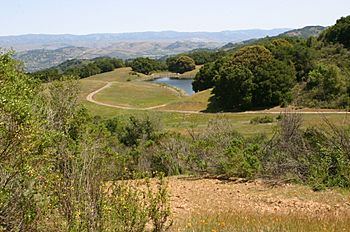Guadalupe Creek (Santa Clara County) facts for kids
Quick facts for kids Guadalupe Creek |
|
|---|---|

View overlooking man-made Cherry Springs Lake, near Cherry Springs, the origin of Guadalupe Creek's Cherry Springs Creek tributary
|
|
| Other name(s) | Los Capitancillos Creek |
| Country | United States |
| State | California |
| Region | Santa Clara County |
| City | Blossom Valley, San Jose, California |
| Physical characteristics | |
| Main source | Mount Umunhum Santa Clara County, California 3,161 ft (963 m) 37°09′31″N 121°53′59″W / 37.15861°N 121.89972°W |
| River mouth | Guadalupe River 197 ft (60 m) 37°14′48″N 121°52′16″W / 37.24667°N 121.87111°W |
| Basin features | |
| Tributaries |
|
Guadalupe Creek is a stream that flows north for about 10.5 miles (17 kilometers) in Santa Clara County, California. It starts near the top of Mount Umunhum. The creek flows along the edge of Almaden Quicksilver County Park.
Guadalupe Creek then joins Los Alamitos Creek after it leaves Lake Almaden. When these two creeks meet, they form the main part of the Guadalupe River. This river then flows through San Jose and empties into the southern part of San Francisco Bay.
Contents
A Look Back in Time
The valley where Guadalupe Creek flows is called "Cañada de los Capitancillos." This Spanish name means "Valley of the Little Captains."
Long ago, people used the river for fun activities like swimming or fishing. This was before the Guadalupe Dam was taken out.
The Creek's Journey and Water System
The area that drains water into Guadalupe Creek is called its subwatershed. This area covers about 14.8 square miles (38.3 square kilometers).
Where the Creek Starts
Guadalupe Creek begins east of the peak of Mount Umunhum. As it flows downstream, other smaller creeks join it.
- First, Rincon Creek joins from the left.
- Then, Los Capitancillos Creek joins from the right.
After these creeks join, the water flows into Guadalupe Reservoir.
Guadalupe Reservoir
The Guadalupe Dam was built in 1935 to create this reservoir. The main goal of the reservoir is to collect water from winter storms. This stored water helps refill the underground water supply during the dry summer months. This process is called "recharging" the water system.
Flowing Downstream
Below Guadalupe Dam, the creek follows Hicks Road. Further down, Cherry Springs Creek (also known as Reynolds Creek) joins from the left. Cherry Springs Creek starts at Cherry Springs and flows all year. It also has a small creek called Hicks Creek that flows into it.
Next, Pheasant Creek joins Guadalupe Creek from the left. It flows below Hicks Road. Finally, Shannon Creek joins from the left where Shannon Road and Hicks Road meet.
Masson Dam and Fish Ladders
Masson Dam is a smaller dam built in 1964. It helps move water into special ponds called percolation ponds. These ponds also help refill underground water.
In 1999, Masson Dam was rebuilt because it was blocking fish from swimming upstream. A special path for fish, called a fish ladder, was added in 2000. This ladder helps fish move past the dam.
Lake Almaden
Guadalupe Creek crosses Almaden Expressway. Soon after, it joins Los Alamitos Creek at Lake Almaden. This is where the Guadalupe River officially begins. Lake Almaden used to be a grassy field. It was formed when people dug out gravel from a quarry.
Most of Guadalupe Creek now flows through natural dirt banks. A short section of concrete channel near Pheasant Creek was removed to make the creek more natural.
Animal and Plant Life
Animals of Guadalupe Creek
Historically, steelhead trout (a type of fish) used to lay their eggs in Guadalupe Creek and its smaller creeks like Pheasant Creek and Hicks Creek. This happened until the 1950s. However, Masson Dam created a barrier that made it hard for them to pass. It's not certain if steelhead trout use the fish ladder built in 2000.
Some rainbow trout, which are related to steelhead, still live in the upper part of Guadalupe Creek above the dam.
Other animals that live in the creek below Guadalupe Dam include:
- The western pond turtle (Actinemys marmorata)
- The foothill yellow-legged frog (Rana boylii)
- Yellow warblers (a type of bird)
- Double-crested cormorants (a type of bird)
- Rainbow trout
Plants of Guadalupe Creek
There are also some rare plants found near Guadalupe Creek:
- Mount Hamilton thistle (Cirsium fontinale var. campylon)
- Santa Clara Valley dudleya (Dudleya setchellii), which is an endangered plant
- Santa Clara red ribbons (Clarkia concinna automixa)
- Fragrant fritillary (Fritillaria liliacea)
- Mount Hamilton jewelflower (Streptanthus callistus)
Mercury in the Creek
Guadalupe Creek has a problem with mercury contamination. This means there's too much mercury in the water.
History of Mercury
In the past, workers from mercury mines would throw leftover mining waste into or near Guadalupe Creek and Los Alamitos Creek. They hoped winter floods would carry the waste away. Guadalupe Reservoir even covers an old mercury processing area.
Today, some of these mining wastes are still found along the banks of Guadalupe Creek. You can see them near the old Guadalupe Mine, outside of Almaden Quicksilver County Park. There's also a pile of mining waste at Hicks Flat, across the creek from the main mine.
Cleaning Up the Creek
In 2001, a part of Guadalupe Creek was cleaned up. This section was about half a mile long, between Almaden Expressway and Masson Dam. Workers removed mercury-contaminated dirt. They also reshaped the creek to make it wind more naturally and planted native plants. This was done as part of a flood control project for downtown San Jose.
Fish Safety Advisory
Because of the mercury, the California Office of Environmental Health Hazard Assessment (OEHHA) has given a safety warning. They advise that no one should eat any fish caught from Guadalupe Creek. This is to keep people safe from mercury.

